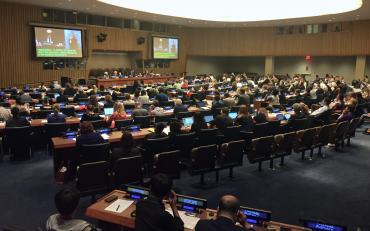On this page:
- UN Convention on the Rights of Persons with Disabilities
- The 2030 Agenda for Sustainable Development
- The Sendai Framework for Disaster Risk Reduction
- Future IASC Guidelines on Inclusion of Persons with Disabilities in Humanitarian Action
- Charter on Inclusion of Persons with Disabilities in Humanitarian Action
1. UN Convention on the Rights of Persons with Disabilities
The UN Convention on the Rights of Persons with Disabilities is a legally binding human rights treaty with an explicit social development dimension, which recognizes the human rights and fundamental freedoms of all persons with disabilities[1]. The Convention’s stand-alone article on situations of risk and humanitarian emergencies (Article 11) requires States Parties to take, in accordance with their obligations under international law, including international humanitarian law and international human rights law, “all necessary measures to ensure the protection and safety of persons with disabilities in situations of risk, including situations of armed conflict, humanitarian emergencies and the occurrence of natural disasters”[2].
Additional articles of the Convention relevant to inclusive humanitarian action include:
- Article 5 (Equality and non-discrimination)
- Article 9 (Accessibility)
- Article 10 (Liberty of movement and nationality)
- Article 32 (International cooperation)
The Convention also recognizes the importance of universal design, defined in
Article 2 as “the design of products, environments, programmes and services to be usable by all people, to the greatest extent possible, without the need for adaptation or specialized design” which shall not exclude assistive devices for particular groups of persons with disabilities where it is needed, and establishes States Parties’ obligation to undertake or promote research and development of universally designed goods, services, equipment and facilities, in line with Article 2, as well as to promote universal design in the development of standards and guidelines.The 2030 Agenda for Sustainable Development, adopted in 2015, promotes the key principle of “leaving no-one behind”. The Sustainable Development Goals include a number of targets relevant to situations of risk and humanitarian emergencies, including 1.5 (building resilience of those in vulnerable situations and reducing their exposure and vulnerability to climate-related extreme events and other economic, social and environmental shocks and disasters); 10.2 (empowering and promoting the social, economic and political inclusion of all), 11.b (development and implementation, in line with the Sendai Framework for Disaster Risk Reduction 2015-2030, holistic disaster risk management at all levels); and 13.1 (strengthening resilience and adaptive capacity to climate-related hazards and natural disasters in all countries).
3. Sendai Framework for Disaster Risk Reduction
The Sendai Framework for Disaster Risk Reduction 2015 – 2030, requires that in addition to certain guiding principles such as inclusive, accessible and non-discriminatory participation, persons with disabilities must be empowered to publicly lead and promote universally accessible response, recovery, rehabilitation and reconstruction approaches[1]. The framework notes the importance of strengthening disaster resilient public and private investments, particularly through “building better from the start to withstand hazards through proper design and construction, including the use of the principles of universal design”[2]. Furthermore, the Framework notes that disaster risk reduction requires a multi-hazard approach and inclusive risk-informed decision-making based on the open exchange and dissemination of disaggregated data.
4. Future IASC Guidelines on Inclusion of Persons with Disabilities in Humanitarian Action
In November 2016, the United Nations Inter-Agency Standing Committee--the UN's primary mechanism for inter-agency coordination of humanitarian assistance--established a time-bound Task Team to develop UN system-wide guidelines on inclusion of persons with disabilities in humanitarian action. Comprising organizations of persons with disabilities, humanitarian and civil society actors and UN agencies, and with the support of Member States, the Task Team will run for a finite period (January 2017 – December 2018) to establish guidelines for inclusive humanitarian action for persons with disabilities, in line with the Convention on the Rights of Persons with Disabilities.
- Find out more information about the development of the IASC Guidelines and how to get involved
5. Charter on Inclusion of Persons with Disabilities in Humanitarian Action
A Charter on Inclusion of Persons with Disabilities in Humanitarian Action was launched during the 2016 World Humanitarian Summit in Istanbul, Turkey. Developed by a wide range of stakeholders, including DPOs, NGOs, UN agencies and governments, the Charter presents five commitments endorsers agree to uphold: non-discrimination; participation; inclusive policy; inclusive response and services; cooperation and coordination. The Charter is a useful tool for humanitarian stakeholders to support greater understanding of how inclusive humanitarian action can be achieved in line with the CRPD.
